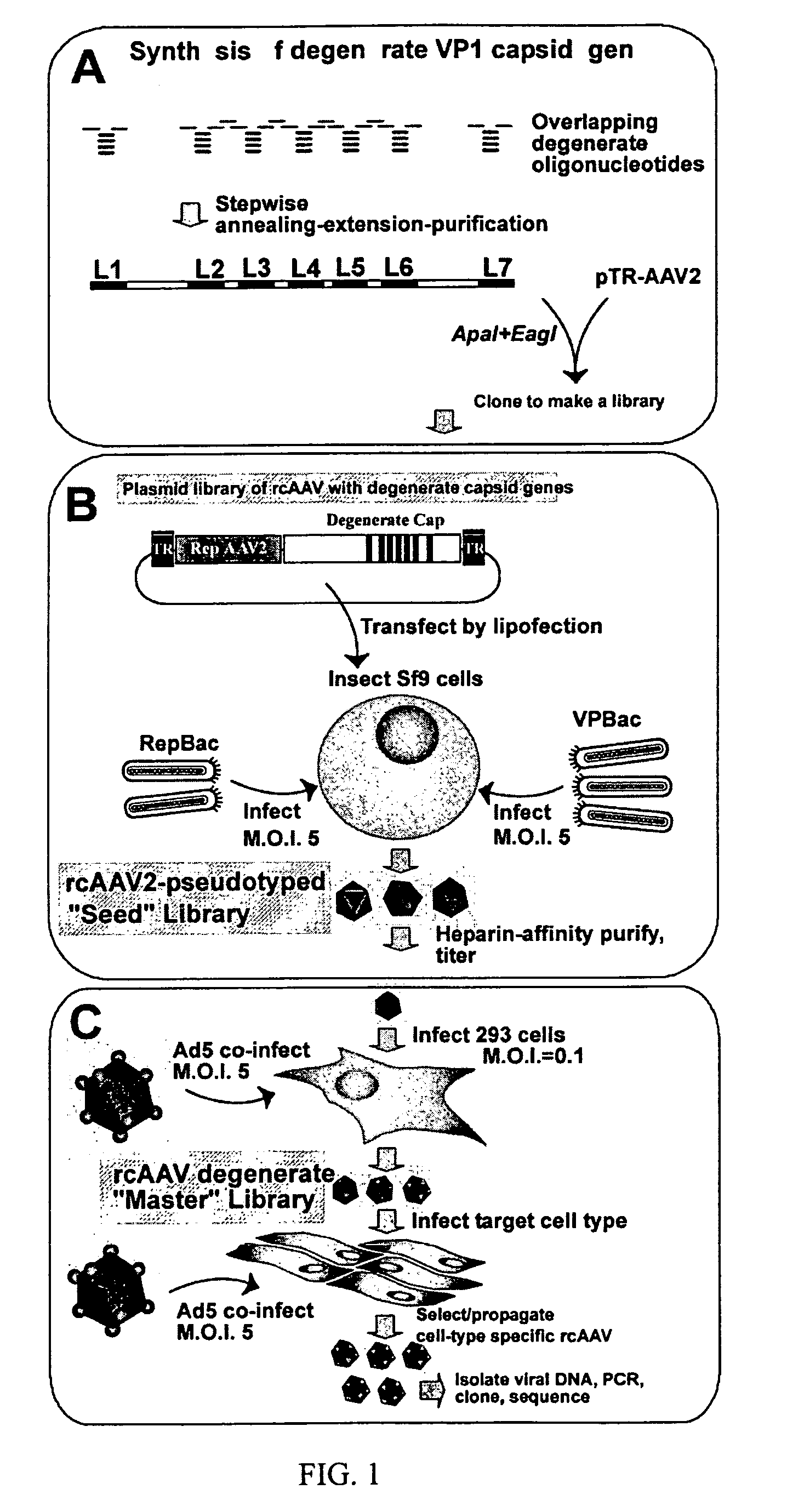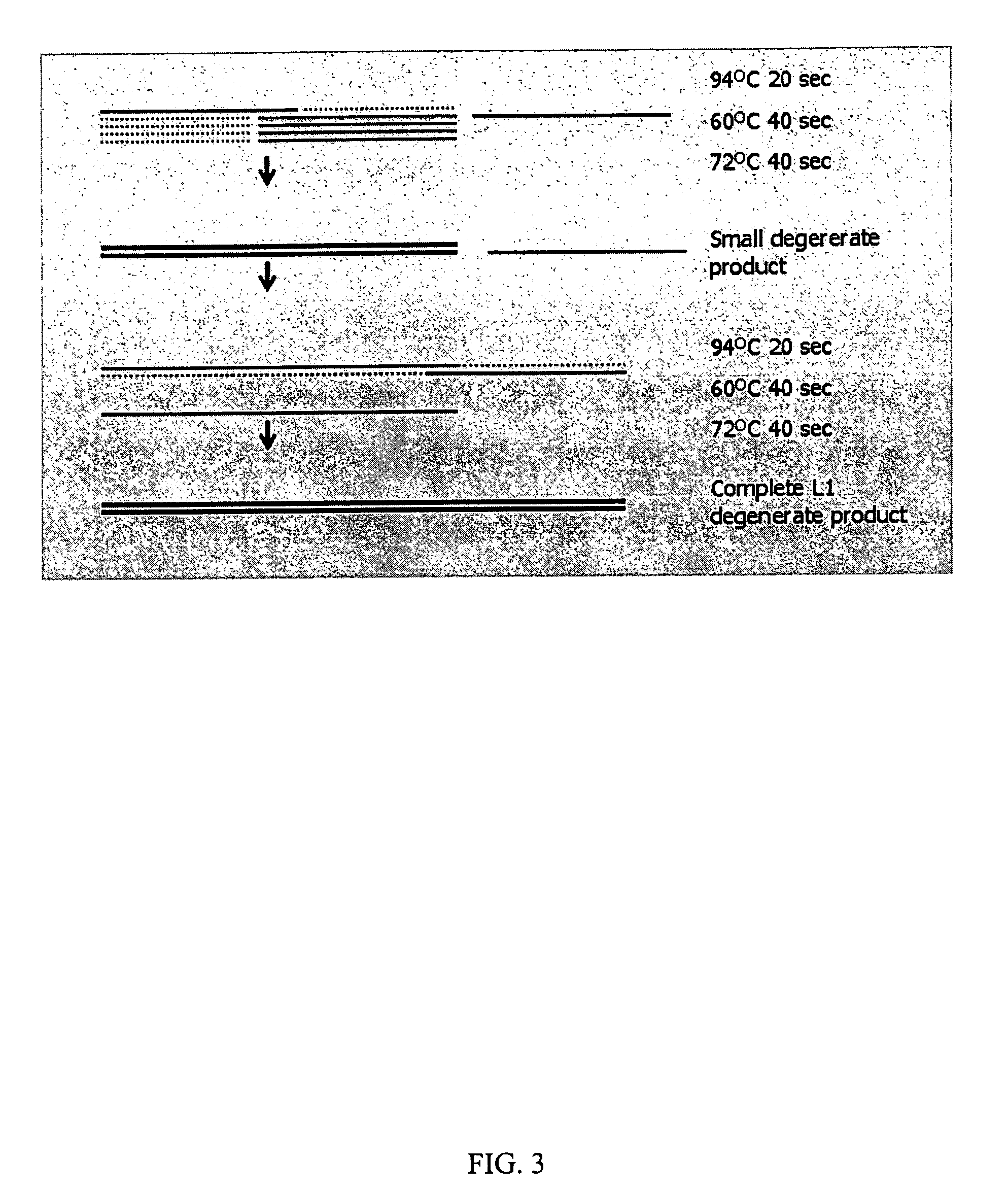Modified AAV
a technology of aav and tropism, applied in the field of molecular biology, gene therapy, virology, can solve the problems of inability to optimize the methods for altering aav tropism, difficult undertaking of producing cell- or tissue-specific aav virions, and inability to achieve large doses of virions, etc., to achieve the effect of facilitating aav replication
- Summary
- Abstract
- Description
- Claims
- Application Information
AI Technical Summary
Benefits of technology
Problems solved by technology
Method used
Image
Examples
example 1
Building Combinatorial Viral Libraries
[0083]To build a combinatorial library, insect cells are employed. Transfection of an Sf9 insect cell line with plasmid DNA using commercially available liposomes routinely reaches 10% of the total cell population yielding about 106 rAAV2-GFP infectious virions / ug of transfected plasmid. At such efficiency, 106 cells (10% of 107 of total number of cells) can be transfected in one T75 flask using only 10 μg of plasmid DNA. This produces 107 infectious viral particles, which sets the upper limit for the complexity of a seed library. Even though this protocol delivers a reasonably high complexity, the possibility that other conditions can further improve the transfection efficiency and final diversity are investigated. For example, in order to further improve the transfection efficiency of Sf9 cells, the plasmid DNA is treated with E. coli DNA gyrase (TopoGen, Columbus, Ohio). In a pilot experiment a Form I TR-containing plasmid DNA pFBGR (Urabe et...
example 2
Analysis of Capsid Gene Homologies of AAV Serotypes 1 Through 5
[0087]In order to develop a viable shuffling strategy, homologies of the respective capsid genes of AAV1–5 were analyzed using AlignX application of the Vector NTI 7 Suite software (InforMax, Inc, Bethesda Md.). A multiple alignment showed that the homologies of capsid genes and proteins were not distributed across the length in a regular fashion. For example, regions containing start codons were considerably less divergent as compared to regions within VP3 (variable domain, Rabinowitz et al., Virology 278:301–308, 2000). The degree of homology / divergence imposes practical considerations on the strategy of library construction. For example, it is technically more feasible to start shuffling DNA species with higher homologies (e.g. closely related serotypes AAV2 and AAV3, or AAV1 and AAV2, Table. 1). At a later stage of shuffling, it is possible to incorporate into the breeding mix more distant relatives and fine-tune the...
example 3
RACHITT-mediated Shuffling of Capsid Genes of AAV Types 1 and 2
[0088]A library of plasmid DNAs containing AAV1 and AAV2 shuffled capsid genes was constructed. Sequencing of 6 library clones supported the notion that RACHITT is an efficacious protocol of generating highly mosaic shuffled genes. Conservative regions of the AAV cap gene have been shuffled, spanning about 1 Kbp and including initiating codons for all three genes (from SwaI@2194 to BsiWI@3256 in AAV2 genome, the fragment encodes a peptide from Met1 to Leu350 of VP1). These segments of the respective cap genes are 85% identical. The RACHITT method was used to recombine two PCR fragments derived from AAV1 and AAV2 genomes respectively. The resulting chimeric library was cloned into pTR-AAV2 plasmid vector replacing the respective fragment of WT AAV2. Six random clones were sequenced and aligned with parent genomes using Aligrix application of Vector NTI 7 Suite software. The clones contained an average of 10.5 recombinatio...
PUM
| Property | Measurement | Unit |
|---|---|---|
| Volume | aaaaa | aaaaa |
| Volume | aaaaa | aaaaa |
| Volume | aaaaa | aaaaa |
Abstract
Description
Claims
Application Information
 Login to View More
Login to View More - R&D
- Intellectual Property
- Life Sciences
- Materials
- Tech Scout
- Unparalleled Data Quality
- Higher Quality Content
- 60% Fewer Hallucinations
Browse by: Latest US Patents, China's latest patents, Technical Efficacy Thesaurus, Application Domain, Technology Topic, Popular Technical Reports.
© 2025 PatSnap. All rights reserved.Legal|Privacy policy|Modern Slavery Act Transparency Statement|Sitemap|About US| Contact US: help@patsnap.com



